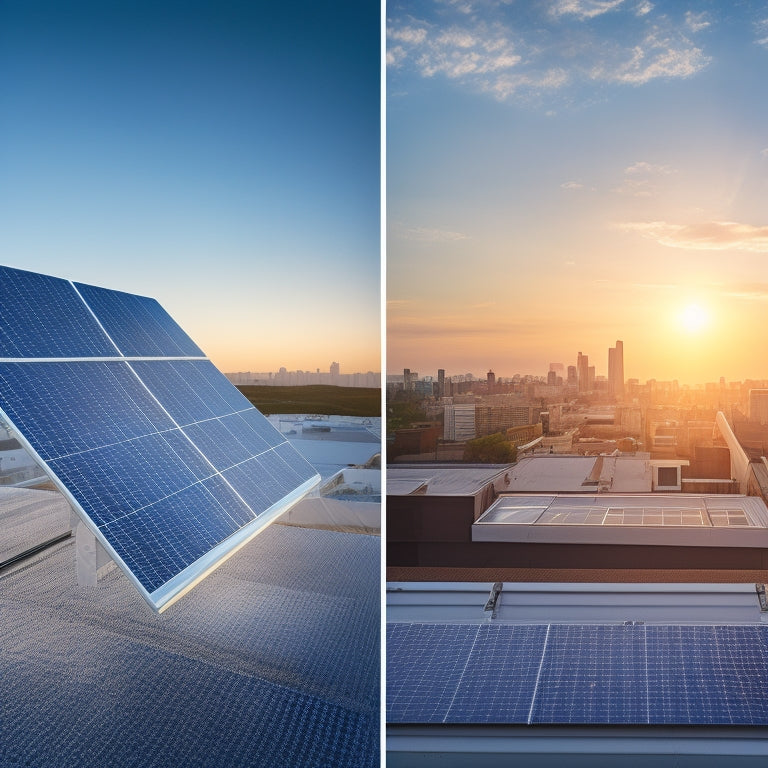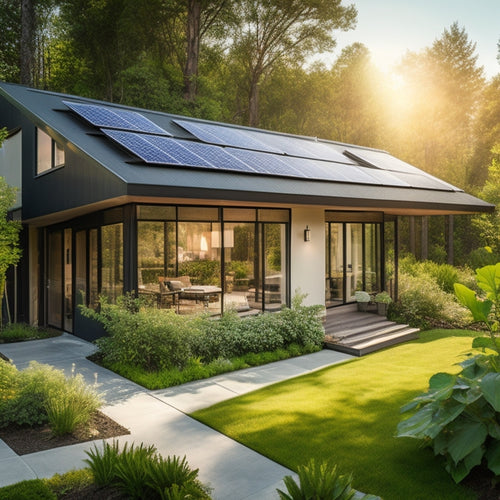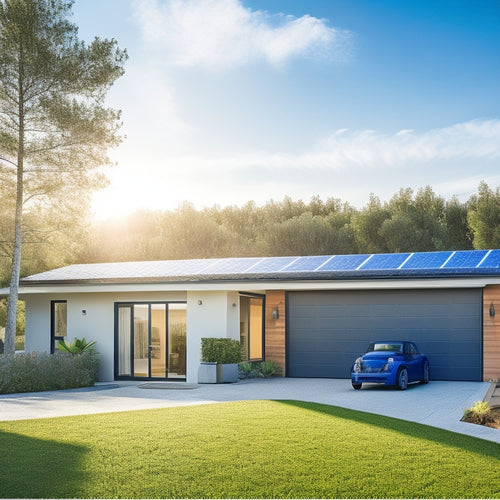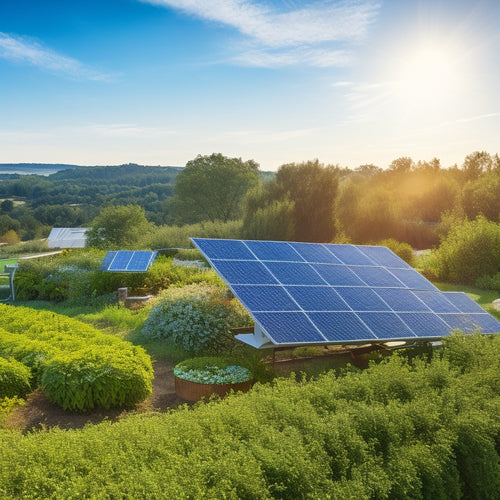
7 Key Considerations for the Cost of Solar Panels Per Watt
Share
You're about to invest in a solar panel system, and understanding the cost per watt is essential to making an informed decision. There are 7 key considerations that impact the cost of solar panels per watt: type and quality of panels, installation costs and labor, system size and energy output, roof size and complexity factors, local incentives and tax credits, manufacturer and dealer markup, and balance of system components. Each of these factors affects the overall cost-effectiveness of your system, and understanding their implications is critical to maximizing your return on investment. As you weigh these considerations, you'll develop a clearer image of what to expect from your solar panel system.
Key Takeaways
- The type and quality of solar panels, including monocrystalline, polycrystalline, and thin-film, impact the cost per watt and overall system efficiency.
- Installation costs, including labor rates and techniques, significantly affect the total cost of the solar panel system, ranging from $0.25 to $1.00 per watt.
- System size and energy output, influenced by factors like roof size and sunlight exposure, impact the cost per watt and overall system cost-effectiveness.
- Local incentives and tax credits, such as the federal solar tax credit, can significantly reduce the cost per watt of solar panel systems.
- Balance of system (BOS) components, including inverters, mounting hardware, and monitoring systems, add to the overall cost per watt of the solar panel system.
Type and Quality of Solar Panels
When shopping for solar panels, the type and quality of the panels are essential factors to take into account, as they greatly impact the overall cost per watt.
You'll want to contemplate the various solar panel types, including monocrystalline, polycrystalline, and thin-film panels. Each type has its own advantages and disadvantages, affecting the panel's durability and efficiency.
Monocrystalline panels, for instance, are highly efficient but also the most expensive. Polycrystalline panels, on the other hand, offer a good balance between efficiency and cost. Thin-film panels are the least expensive, but their efficiency is lower.
You should also look for panels with high-quality materials and a durable design to guarantee they can withstand harsh weather conditions and last for many years.
Panel durability is critical, as it directly affects the system's overall performance and lifespan. Look for panels with a high temperature coefficient, indicating they can maintain their efficiency even in hot temperatures.
Additionally, check the manufacturer's warranty and certifications, such as UL and IEC, to verify the panels meet industry standards.
Installation Costs and Labor
Beyond the cost of the solar panels themselves, installation costs and labor expenses are significant factors to reflect on in your overall budget.
You'll need to evaluate the installation techniques used by the contractor, as these can greatly impact the final cost. For instance, roof-mounted systems typically require more labor and materials than ground-mounted systems, driving up costs.
Additionally, the complexity of the installation, such as traversing multiple roof angles or dealing with shade from surrounding structures, can also increase labor rates.
Labor rates vary widely depending on the location, contractor, and type of installation. On average, labor costs range from $0.25 to $1.00 per watt, with the national average hovering around $0.50 per watt.
When selecting a contractor, be certain to research their installation techniques, labor rates, and reputation to guarantee you're getting the best value for your money.
System Size and Energy Output
When you're evaluating the cost of solar panels per watt, you need to take into account the system size and energy output.
The capacity of your system matters, as it directly affects how much energy you'll produce, and panel efficiency plays a significant role in determining your energy yield.
You'll want to set clear expectations for your system's energy output to guarantee it meets your needs.
System Capacity Matters
Your solar panel system's capacity, measured in watts (W), directly impacts the amount of electricity it produces. A higher-capacity system generates more power, which can offset your energy consumption and reduce your reliance on the grid.
When considering the cost of solar panels per watt, it's crucial to evaluate your energy needs and determine the best system size for your property.
A larger system capacity doesn't always translate to higher costs, though. While the initial investment may be greater, a more extensive system can provide long-term benefits, such as increased system longevity and lower maintenance costs.
A larger system can also provide a buffer against potential energy losses due to shading, inverter inefficiencies, or panel degradation.
When sizing your solar panel system, consider your energy usage patterns, roof size, and local building codes. A properly sized system will maximize your energy production while minimizing waste and ensuring a stronger return on investment.
Panel Efficiency Impact
As you determine the ideal system size for your property, it's equally important to contemplate the impact of panel efficiency on your system's overall energy output. A more efficient panel can generate more power per hour of sunlight, reducing the required system size and ultimately saving you space and money.
| Efficiency Rating | System Size Required |
|---|---|
| 15% | 8,000 watts |
| 18% | 6,667 watts |
| 20% | 5,714 watts |
Panel efficiency ratings typically range from 15% to 20%. While higher efficiency ratings may come at a higher upfront cost, they can also lead to increased panel longevity and reduced maintenance costs over time. When evaluating solar panels, consider not only the cost per watt but also the efficiency ratings and how they'll impact your system's overall energy output. By doing so, you'll be able to make an informed decision that meets your energy needs while staying within your budget.
Energy Yield Expectations
Considering your location and system size, it's crucial to understand the energy yield expectations for your solar panel system. This involves evaluating the amount of energy your system can produce based on sunlight availability, weather effects, and system design. A thorough shading analysis will help identify areas where energy production might be compromised.
Panel orientation, system durability, and geographical location also play critical roles in determining energy yield. In regions with high temperatures, humidity, or extreme weather conditions, energy production may be lower. Conversely, areas with abundant sunlight and ideal panel orientation can maximize energy output.
Maintenance costs should also be factored into your energy yield expectations, as regular cleaning and upkeep can guarantee optimal system performance.
When evaluating energy yield expectations, consider the system's capacity to produce energy in kilowatt-hours (kWh) per year. This will give you a clear understanding of the system's potential to meet your energy needs.
Roof Size and Complexity Factors
The size and intricacies of your roof play a significant role in determining the cost of solar panels per watt. The installation process becomes more complicated when dealing with unique roof shapes, multiple levels, or obstructions, which can increase the overall cost.
-
Roof orientation: The direction your roof faces affects the amount of sunlight it receives. Ideally, a south-facing roof with little to no shading is perfect for solar panels. However, if your roof has an east- or west-facing orientation, you may need more panels to achieve the same energy output, increasing the cost.
-
Shading issues: Shading from trees, chimneys, or other obstructions can reduce energy production. Your installation team may need to add more panels or use specialized equipment to work around these issues, adding to the cost.
-
Roof material and condition: The type and condition of your roof can impact the installation process. For example, older or damaged roofs may require additional repairs or replacement before installing solar panels, increasing the overall cost.
- Obstacles and intricacies: Skylights, vents, or other roof features can create installation challenges, requiring more time and materials, and consequently increasing the cost per watt.
Local Incentives and Tax Credits
You'll also want to evaluate the local incentives and tax credits that can help offset the cost of your solar panel system.
The Federal Solar Tax Credit, for example, allows you to claim a credit of 26% of the total cost of your system.
Additionally, many states and local governments offer rebates and incentives that can further reduce the upfront cost of going solar.
Federal Solar Tax Credit
In addition to state and local incentives, the federal government offers a considerable tax credit to homeowners and businesses investing in solar energy. As you consider the cost of solar panels per watt, you'll want to factor in this beneficial incentive.
To qualify for the federal solar tax credit, you'll need to meet certain eligibility requirements:
-
Residential and commercial properties: The tax credit is available to homeowners and businesses that install solar panel systems on their properties.
-
Primary or secondary residences: The credit applies to primary and secondary homes, as well as rental properties.
-
Newly installed systems: The tax credit only applies to newly installed solar panel systems, not existing ones.
- System size and cost: The credit is based on the total cost of the solar panel system, including installation, and is capped at $2,000 for residential systems.
When calculating your tax credit, you'll need to determine your eligibility and the total cost of your solar panel system.
The federal solar tax credit can considerably reduce your overall cost, making solar energy a more accessible and affordable option for you.
State and Local Rebates
Beyond federal incentives, state and local governments offer rebates and tax credits to further reduce the cost of solar panels per watt.
You'll need to research the specific programs available in your area, as they vary widely. State rebates, for instance, can provide a significant discount on your solar panel system. Local programs, on the other hand, may offer additional incentives, such as property tax exemptions or low-interest loans.
To take advantage of these incentives, you'll need to meet the eligibility criteria, which typically include installing a solar panel system that meets certain efficiency and safety standards.
The application process usually involves submitting an application, along with documentation of your system's installation and performance.
Be aware that funding limits may apply, and popular programs may close quickly due to high market demand.
Manufacturer and Dealer Markup
Your solar panel system's final cost is considerably influenced by the manufacturer and dealer markup, which can range from 10% to 50% of the total price. This markup is a significant factor in determining the overall cost of your solar panel system.
When it comes to manufacturer pricing, you should be aware that different manufacturers have different pricing strategies. Some manufacturers may offer premium products at a higher price point, while others may offer more affordable options.
Here are 4 key factors that affect manufacturer and dealer markup:
-
Research and Development: Manufacturers invest heavily in R&D to improve the efficiency and quality of their solar panels, which is reflected in the final price.
-
Marketing and Advertising: Manufacturers and dealers spend money on marketing and advertising, which adds to the cost of the solar panel system.
-
Distribution and Logistics: The cost of transporting and storing solar panels also contributes to the markup.
- Profit Margins: Manufacturers and dealers need to make a profit, which is factored into the final price of the solar panel system.
Understanding these factors can help you make an informed decision when purchasing a solar panel system.
Balance of System Components
Solar panel systems comprise more than just panels; they require a range of Balance of System (BOS) components to operate efficiently. When designing your system, you'll need to take into account component compatibility, energy storage, and inverter selection to guarantee peak performance.
| Component | Function | Cost Range |
|---|---|---|
| Inverter | Converts DC power to AC | $0.15-$0.30 per watt |
| Mounting Hardware | Secures panels to roof or ground | $0.05-$0.15 per watt |
| Monitoring System | Tracks system performance | $0.05-$0.10 per watt |
| Energy Storage | Stores excess energy for later use | $0.10-$0.20 per watt |
| Electrical Panel | Distributes power to your home | $0.05-$0.10 per watt |
You'll also need to factor in maintenance costs, warranty considerations, and installation permits when calculating the total cost of your solar panel system. A well-designed system with compatible components can guarantee maximum energy output and reduce the overall cost per watt. By carefully evaluating these BOS components, you can enhance your system's performance and achieve a lower cost per watt.
Frequently Asked Questions
Do Solar Panels Work During Power Outages?
You're wondering if solar panels work during power outages. The answer is, they don't - unless you have an off-grid system with backup batteries, which allow you to store excess energy generated during the day for use during outages.
Can I Install Solar Panels Myself?
"Quoth the savvy homeowner, thou venturest into DIY solar? While possible, thou shouldst heed warnings: solar panel installation demands precise electrical know-how, lest thou risk shock, fire, or system malfunction.
How Long Does It Take to Install Solar Panels?
You'll typically need 1-3 days for a residential solar panel installation, depending on the complexity of the installation process and your roof's size. The installation timeline varies, but a standard installation process usually takes around 2 days for a single-family home.
Can I Finance or Lease Solar Panels?
You can finance or lease solar panels, exploring solar panel financing options or solar lease options, which allow you to benefit from renewable energy while managing upfront costs, with varying contract terms and monthly payments.
Are Solar Panels Affected by Weather Conditions?
You'll be interested to know that even on cloudy days, solar panels can still generate 25% of their maximum power output. Weather conditions indeed impact solar efficiency, with temperature, humidity, and cloud cover affecting performance, but modern panels are designed to mitigate this weather impact.
Conclusion
As you weigh the cost of solar panels per watt, remember that a detailed understanding of these 7 key factors is essential. The type and quality of solar panels, installation costs, system size, roof complexity, local incentives, manufacturer markup, and balance of system components all play a role in determining the final cost. By carefully considering each of these elements, you'll be well-equipped to make an informed decision that aligns with your energy goals and budget.
Related Posts
-

Integrating Solar Panels Into Home Design
Integrating solar panels into your home design greatly enhances energy efficiency and lowers utility bills while addi...
-

Solar Energy Storage Options for Homes
When considering solar energy storage options for your home, you'll find several effective solutions. Battery systems...
-

Green Energy Alternatives for Independent Living
To enhance your independent living, consider green energy alternatives like solar panels and wind turbines. These opt...


